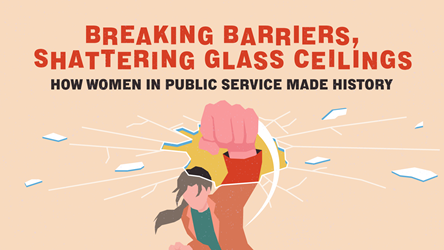ASEAN Chairmanship: Behind The Scenes With The MFA

A delegation’s request to install an oversized refrigerator in their room, another request to break down a door to accommodate a large sofa, and special arrangements for New Zealand Prime Minister Jacinda Ardern’s baby, who stayed home in the end.
These were some of the colourful encounters the ASEAN Chairmanship Steering Committee had, revealed Conference Sub-committee member Ms Sumaya Baqavi, Assistant Director (Europe Directorate) at the Ministry of Foreign Affairs (MFA).
The MFA team took all these in stride, overcoming bigger challenges and achieving much more in the lead up to Singapore’s ASEAN Chairmanship in 2018.
Being the ASEAN Chair is an opportunity that comes around only once every 10 years, with all ASEAN member states taking turns to assume the role.
The MFA saw this as more than just an obligation to fulfil, said Mr Peter Tan, MFA Deputy Secretary (Southeast Asia & ASEAN), who led the Steering Committee. “We wanted to make full use of the opportunity to present our vision of how we can take the region forward.”

Building “Resilience and Innovation”
Preparations began as early as 2016, with the MFA consulting other ministries, public agencies and thought leaders to develop the theme for the year, as well as potential initiatives to introduce during the Chairmanship.
For Mr Navjeev Singh from the MFA’s ASEAN Directorate, it was “the largest brainstorming exercise” he had taken part in. After many discussions, the theme of “Resilience” was chosen in response to the challenges and threats facing the region such as terrorism, transnational crime and climate change.
“Innovation”, which Mr Singh suggested, was also selected to highlight the potential impact of the ongoing digital revolution in the region. Singapore had launched its Smart Nation Initiative in 2014.
In 2016, ASEAN had yet to fully realise the opportunities and challenges associated with digitalisation. Singapore’s Chairmanship offered “the perfect platform” to spur change and boost digital innovation, said Mr Singh.
A Smart Cities Network
A major initiative was the launch of the ASEAN Smart Cities Network (ASCN), a platform to help ASEAN cities work with partners to develop sustainable urban solutions.
The ASCN is a long-term, multi-year initiative, and there were many things Singapore had to achieve in the first year to ensure its sustainability, said Mr Singh, who co-led the ASCN’s establishment. This included creating a common Smart Cities framework, nominating pilot cities for the network, developing city-specific action plans, and establishing partnerships between these pilot cities and ASEAN’s external partners.
Co-led by the MFA and the Centre for Liveable Cities (CLC), the ASCN involved many public agencies, such as the Ministry of Trade and Industry, the Ministry of Social and Family Development, Enterprise Singapore, and the Economic Development Board.
With multiple public agencies and countries to coordinate, there were concerns that the plan was “too ambitious” for one year’s work, Mr Singh said.
But Singapore succeeded in developing action plans for 26 pilot cities and facilitating 33 partnerships for these cities – achievements that Mr Singh said was thanks to “sheer hard work” and a collaborative spirit from the inter-agency team.

Projects involving multiple governments can only succeed when “all parties feel that their interests have been taken into account”, Mr Singh said, so his team focused on win-win collaborations and how people in ASEAN could benefit from the network
Managing events sensitively
The themes of “Resilience” and “Innovation” permeated throughout Singapore’s ASEAN Chairmanship, including the logistical arrangements, said Mr Tan.
To demonstrate the power of innovation, Singapore used various technologies at different ASEAN events, such as video conferencing and an online collaboration space for delegates to work on documents in real time. Robotics was also on display. For the 33rd ASEAN Summit and related summits, the Singapore Police Force deployed a robot to patrol the venue.
Events were planned with political sensitivities taken into account, down to the design of the overall venue layout to avoid any “diplomatic ‘incidents’ along corridors”, said Ms Baqavi.
To cater to the delegates’ tight schedules, the Steering Committee combined meetings and social meals into working meals. They also accommodated VVIPs being late for meetings and assisted whenever ad-hoc requests popped up.
But as for the unusual requests to accommodate large furniture and appliances, space and power constraints meant that these were simply not possible.
At such large-scale events, some glitches were inevitable, Ms Baqavi added. For instance, there were unexpected power trips and a last-minute discovery of an incorrectly positioned country flag – but the team’s fast thinking resolved the mishaps in time.
A nation-wide effort
Looking back, Mr Tan believes that Singapore, as ASEAN Chair, has achieved far more than the team dared to expect at the start.
Despite moments of frustration, “days without nights and times without weekends”, he said, all the different groups – government agencies, the media, universities and think tanks, and the private sector – came together and ultimately made Singapore’s Chairmanship a success.
Beyond the outcomes, Mr Tan said it was also important to learn from the process, seek improvements, and appreciate the “journey of camaraderie” with all others who played a part.
The journey continues with much work to be done, as the team has agreed to shepherd the ASCN beyond 2018. Mr Tan said: "We envision the ASCN to be a long-term endeavour that will have a lasting impact on ASEAN.”

- POSTED ON
Feb 28, 2019
- TEXT BY
Fiona Liaw
- ILLUSTRATION BY
Mushroomhead









